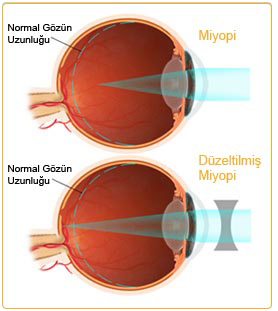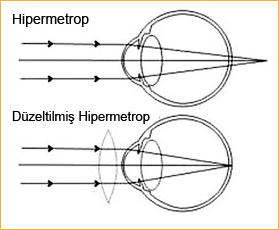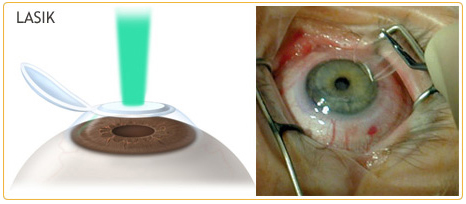Refractive Errors

A refractive error is the most common eye problem and a frequent reason for reduced visual acuity. It is not a disease of the eye, but a disorder. Normally, light is refracted or bent by the cornea and lens onto the retina at the back of an eye to create clear images. When the eye doesn't refract light properly and vision is blurred.
An eye that has no refractive error when viewing a distant object is said to have emmetropia.
There are different types of refractive error:
Myopia or nearsightedness occurs when the image of a distant object becomes focused in front the retina because the axis of the eyeball axis is too long and/or the eye's refractive power is too strong. Myopia makes distant objects appear out of focus. Myopia usually develops between the ages of 10-15 but can occur at younger ages.
Hyperopia or farsightedness occurs when the image of a distant object becomes focused behind the retina because the axis of the eyeball is too short and/or the eye's refractive power is too weak. Hyperopia makes close objects appear out of focus.
Astigmatism occurs when an abnormal curvature of the cornea can cause two focal points to fall in two different locations. Astigmatism makes both near and far objects appear blurry. Presbyopia is caused when the center of the lens in the eye hardens so that it is unable to focus up close; this condition generally affects those over the age of 40.
It is possible to have more than one refractive error, such as having both myopia and astigmatism.

In most cases, refractive error is easily remedied by corrective eyeglasses.
Without eyeglasses, children with refractive error struggle in school and leading poor academic performance. So, corrective eyeglasses are as essential as books, papers, and pencils.
Untreated refractive error in adults may not be life threatening, but they can be quality-of-life threatening by negatively affecting academic achievement, social adjustment, and economic survival.
People with severe myopia have a higher risk of detached retina and neovascularization at the back of the eye.
The eye's ability to refract or focus light sharply on the retina is based on two main anatomic features: the overall length of the eye and the curvature of the eye's surface or cornea. The tear film, crystalline lens, and internal fluids also play a role in focusing an image onto the retina. An irregularly shaped natural lens or defect in the way it functions also can cause focusing problems, leading to blurry or distorted vision.
Both nearsightedness and farsightedness can be inherited.
When you are young, the lens in your eye is soft and flexible. The lens can change its shape easily, allowing you to focus on objects both near and far away. After age 40, the lens becomes more rigid and cannot change shape as easily as it once did. As a result, it is more difficult for the eye to focus clearly on close objects. Reading and performing other close-up tasks such as threading a needle can become very difficult. Presbyopia is a normal part of aging.
The four most common refractive errors are
Myopia (nearsightedness)
Close objects look clear, but distant objects appear blurred.
Hyperopia (farsightedness)
The words on a page will seem blurry, or it will be difficult to see to thread a needle.
Astigmatism (distorted vision)
Astigmatism distorts or blurs vision for both near and far objects. It's almost like looking into a fun house mirror in which you appear too tall, too wide or too thin.
Presbyopia (aging eye)
You may start to notice presbyopia around the age of 40, when you begin to hold reading materials farther away from your face in order to see them more clearly. This familiar event is often the first sign of presbyopia, which, if left uncorrected, can cause eye fatigue and headaches.

An ophthalmologist conducts an eye exam with the help of an instrument called a phoropter. This contains a number of lenses of varying power. By having an individual look at an eye chart through these lenses, the doctor can estimate the amount of refractive error. A retinoscope is also used to shine a light into the patient's eye and view the reflection from the retina in the back of the eye.
The process of showing a patient these lenses of progressively stronger or weaker power is called refraction.
Refractive errors are just one potential cause of blurred vision, so it is important to have an examination right away if you are experiencing symptoms.
A refraction from an eye care practitioner helps determine the type and degree of refractive error, which may be addressed with glasses, contacts, or refractive surgery.
Eyeglass lenses and contact lenses are produced with precise curvatures that help offset flaws in the eye's optical system. These lenses intercept and bend light rays, such that they achieve a more precise point of focus on retina.

Many vision correction surgeries such as LASIK also aim to correct refractive errors by changing the shape of our eye's front surface, so that light rays are bent into a more accurate point of focus.
There are several alternatives to correct your vision. You should discuss your vision and your lifestyle with your ophthalmologist to decide which of these will be best for you.
Last Updated: October 23, 2024



























